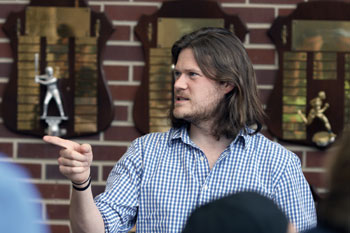Back on Campus:In Charge of Everything Else |
| Printer-friendly version | Email this article |
|
After congratulating Michael, WM just had to ask: So what does a production designer do, anyway? Bricker: I’m in charge of the visual landscape of the film. What I do varies on the scale and budget of the movie [Bricker’s previous effort in production design was the Muncie-based My Name is Jerry.] Essentially, I’m the head of the art department. One way it’s been explained to me is that the director, cinematographer, and production designer are this creative triangle. The director is primarily in charge of performances, the cinematographer is in charge of the cameras and lighting, and the production designer is pretty much in charge of everything else. That includes location, sets, costumes (at least there’s a conversation there with the costumer), props, set dressing, and decorating. Of course, if you ask a director or cinematographer, they’ll probably have their own “in charge of everything else” sort of answer for their role! Natural Selection is an independent film—a lower budget film—and the smaller the budget, the more hats different people wear. What did you do at Wabash that prepared you for this? Bricker: I did set design for theater, which is sort of the equivalent of production design. You were known for your collaborative efforts here. Bricker: That collaboration is my favorite part of production design, too. There are not many fields where the creative power shifts so quickly from person to person. You’re working with experts, and you have to wait and let them be experts. There’s a constant change of who has the creativity and the power, and that goes on throughout the film. It’s equal parts design and execution. Say, at the end of a scene, the director wants a space to feel slightly more open than at the beginning, the production designer may open the curtain, the cinematographer may warm the scene with lighting, then the editor can do his part. And there are so many places it can go wrong. You improvise with what you’ve got. A good example is the house you see in the film, where Raymond is living. We found that house in Smithville, TX, and no one had lived there for a while. We had to pay to have the power turned on to shoot. And it was kind of caving in, it was as bad as it looks. Can you give us an example of how this “visual landscape” moves the story forward in this particular film? Bricker: You’ll notice a theme of dead flowers and lifeless plants throughout the film. In the house where the couple lives, the wallpaper is denim blue with dying flowers; we put dried flowers in the bathroom. There are bare bed sheets, dead grass—sterility, division depicted visually. Some production designers are more interested in big sets or period pieces, but I’m much more interested in production design that is more real, that enhances the reality of the story. I want to do those big-budget films some day, sure, but there are lots of stories that don’t need that. Natural Selection was one of them. Watch the film’s trailer at WM Online
|

 Michael Bricker ’04 was production designer for Natural Selection, the indie film that garnered critical praise, took the South by Southwest Film Festival by storm, and opened new opportunities for the architect/artist/entrepreneur who spent last semester teaching architecture at Wabash.
Michael Bricker ’04 was production designer for Natural Selection, the indie film that garnered critical praise, took the South by Southwest Film Festival by storm, and opened new opportunities for the architect/artist/entrepreneur who spent last semester teaching architecture at Wabash.